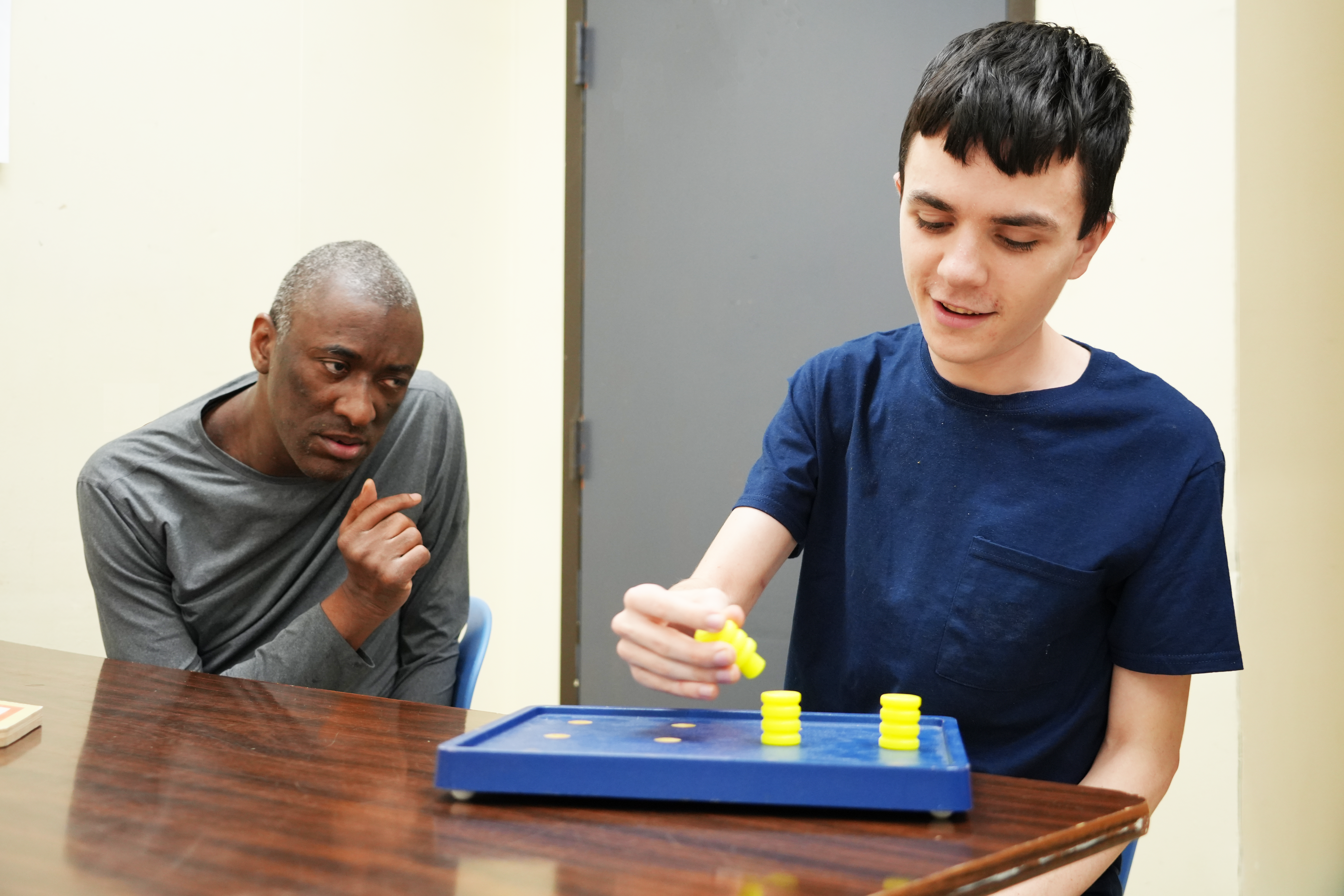The Centers for Medicare & Medicaid Services (CMS) implemented new regulations for Medicaid’s 1915(c) Home and Community-Based Services (HCBS) waivers on March 17, 2014.
The intent of the HCBS Settings Rule is:
- To ensure that individuals receiving long-term services and support through home and community-based service (HCBS) programs under the 1915 (c) Medicaid authorities have:
- full access to benefits of community living, and
- the opportunity to receive services in the most integrated setting that is appropriate, based on assessed needs.
- To enhance the quality of HCBS settings and provide protections to participants

Screen reader transcription of image above
Home and Community-Based Settings must be integrated and support access to the greater community and provide opportunities to seek employment and work in competitive, integrated settings, engage in community life, and control personal resources. They must also ensure the person supported receives services in the community to the same degree of access as individuals not receiving Medicaid home and community-based services. HCBS settings should be selected by the person supported from among setting options, including non-disability specific settings and an option for a private unit in a residential setting.
CMS Settings Rule
SCDHHS HCBS State Transition Plan website
BHDD-OIDD HCBS Provider Information (PDF)
The Council on Quality and Leadership Website
CQL Toolkit for States
CQL Quality in Practice Guide: Rights and Responsibilities
CQL Quality in Practice Guide: Safety
HCBS Settings, Regulations and Basic Assurances (PDF)
Understanding Basic Assurances in South Carolina (PDF)
Relocation Stress Syndrome (PDF)
South Carolina HCBS Summary of Findings (PDF)
AUTONOMY, EMPOWERMENT & SUPPORTED DECISION-MAKING
FAIR TREATMENT: HOW CAN WE SUPPORT THIS OUTCOME?
HCBS Advocates Guide- Your Right to A Community Life
Supporting the Right to A Community Life- Supporting People to Advocate
HCBS Advocacy- National Resources
HCBS Advocacy- Advocates Worksheet
HCBS Implementation Resources:
- HCBS Answers to Provider Questions (PDF)
- HCBS Workshop 1: Food and Visitors (PDF)
- HCBS Workshop 2: Leases and Money (PDF)
- HCBS Workshop 2: Leases and Money - Video (YouTube)
- HCBS Workshop 3: Key, DOL Posters, Person-Centered Planning Autonomy (PDF)
- Video of HCBS Workshop 3: Key, DOL Posters, Person-Centered Planning Autonomy (YouTube)
- HCBS Workshop 4: Day Services, Service Plans, Setting Selection, Staff Selection (PDF)
- Video of HCBS Workshop 4: Day Services, Service Plans, Setting Selection, Staff Selection (YouTube)
- Video of HCBS Workshop 5: Visitors (YouTube)
- HCBS Workshop 5: Visitors (PDF)
- HCBS Workshop 5 - CAP Process (PDF)
- Video of HCBS Workshop 6: Compliance Action Plans (YouTube)
- HCBS Workshop 7: DHEC CRCF (PPT)
- Video of HCBS Workshop 7: DHEC CRCF (YouTube)
- HCBS Reference for Case Management Monitoring (PDF)
- Video of HCBS Workshop 8: Choice and Communication
- HCBS Reference for Core English AAC Vocabulary page (PDF)
- CAP Work Session (PDF)
- HCBS Rule Work Group Meeting June 6, 2019 (PDF)
Videos:
Exploring Aspects of the HCBS Settings Regulations - YouTube
Introduction To Social Capital - YouTube
Webinars:
HCBS Settings Regulations: What Do They Mean For You?
Building Social Capita
South Carolina Home and Community-Based Services Positive Practices - Residential Services
| Rights | “Individual has rights of privacy, dignity and respect, and freedom from coercion and restraint”
- Participants receive training on rights.
- Rights information is posted in an area easily accessible to the participant.
- No rights are restricted without due process and a plan to clearly restore the right.
- Participants are informed of the process for filing grievances or complaints.
- Participants freely express complaints without fear of staff imposed consequences.
- Regular ANE training is provided and participants are familiar with reporting options. If participants miss the scheduled trainings, staff provide individual make-up sessions.
- The setting prohibits the use of un-authorized restraining interventions such as seclusion, physical restraints, chemical restraints, or locked doors.
|
|---|
| Choices | “Individual is provided choice regarding services and supports, and who provides them”
- Participants are involved in the interview process for staff.
- Staff are given a trial run in the home where they spend a couple days working there.
- Individuals actively participate in choosing who they want to work with/deciding their staff person.
- Participants can decorate their bedrooms in the manner of their choosing.
|
|---|
| Autonomy | “Individual has autonomy, and independence in making life choices, where possible”
- Participants can go inside, outside, and to all common areas of the home at their choosing.
- Participants do not have to go to their rooms or bed at a specific time each evening and they have reasonable flexibility for wake up times.
- Participants make decisions on how they spend their free time and the activities that they are involved in reflects their individual interests and choices.
- Participants are included in the development of a financial plan and help determine how their money is spent.
- Participants are included in meal preparation, meal planning and shopping for ingredients.
- Participants take an active role in performing laundry, cleaning, and household chores according to their abilities
- Individuals are afforded privacy in receipt and sending of mail.
- Individuals are afforded privacy in receipt and making of phone calls.
- Wi-Fi or computer is available in the home for participant’s usage.
|
|---|
| Integration | “The setting is integrated and supports full access of Individuals to the greater community to the same degree of access as individuals not receiving Medicaid HCBS”
- Group and individual activities are planned with input from the Participants rather than chosen by staff.
- Staff help participants build community integration and natural supports through independent/individualized events and/or volunteer opportunities.
- A Calendar of Community Events is posted in a public place so individuals are aware of what is going on in their area.
- Participants or groups of participants get together to plan and discuss what they would like to do and staff help execute the plan.
- Participants are supported to achieve their employment and/or volunteer goals.
- Participants are supported to learn job skills, develop resumes and practice completing job applications.
- Participants are supported in achieving academic goals and greater independence to transition from the HCBS programs.
- Participants develop and have ongoing relationships with non-waiver receiving neighbors and community members.
- Public support groups are identified, as well as speaking events, and other public recreational events such as community concerts and picnics in the park.
- Participants run errands independent of their housemates.
- Participants go on outings with family members, friends, or other people important to them.
|
|---|
Positive Practices - Non-Residential Services
| Setting Selection | “Individual selects both the setting (location) and provider from among setting options”
- Participants are provided options when choosing the setting, including non-disability specific settings.
- Participants know how to and are able to request a change in their living situation.
- The setting is free from postings of employee information (such as labor standards and minimum wage posters) in common areas and visible to residents.
|
|---|
| Accessibility | “The setting is physically accessible to the individual”
- Ramps are present to access the home, if needed by participants residing in the home. Grab bars are available for those who need them.
- Public transportation is accessible, where available.
|
|---|
| Privacy | “Individual has privacy in their sleeping or living unit”
- Individuals have their own rooms/apartment or person has been accommodated to share a room/apartment and maintain privacy.
- Cordless or cell phones are available for individuals to speak in private. Wi-Fi is available in bedrooms.
- Participant's health information is only discussed with those authorized by the person.
- Health information is stored in a secure location which is only accessible to staff with a need to know.
- Participant's schedules for PT, OT, medications, restricted diet, etc. are kept private.
- Health related and personal care activities (ex: blood pressure readings, medication administration, personal hygiene, etc.), including discussions of health, are conducted in private locations.
|
|---|
| Locks | “Units have entrance doors that are lockable by the individual, with only appropriate staff having keys”
- Bedroom doors are lockable from the inside, and/or the individual has a key to their bedroom
- Participants have keys to the home or apartment and keys to their rooms, unless otherwise specified in the participant's plan.
- Participants can lock the bathroom door, unless otherwise specified in the person’s plan.
- The setting provides a secure place for Participants to store personal belongings.
|
|---|
| Personalization | “Individual has the freedom to furnish/decorate the living unit within the lease or other agreement”
- Bedroom is decorated to the individual’s taste.
- Bedrooms exhibit differing levels of tidiness representing that the individual is able to control how their room is maintained.
|
|---|
Lease
Agreement | “Individual has a legally enforceable agreement documenting the eviction and appeals process”
- Lease agreements are in place for each participant.
|
|---|
Roommate
Selection | “Individual has choice of roommates/housemates”
- Interview/getting to know each other process is in place for roommates. Potential roommates come to dinner, spend time together away from the residence, and maybe stay overnight before a decision is made that they will move in.
- The participant is involved in the selection of a roommate when living alone is not a viable option.
|
|---|
| Visitors | “Individual is able to have visitors of their choosing at any time”
- No schedule in place for when visitors are allowed.
- Staff help participants coordinate arrangements to see their friends and families.
- Staff support participants in planning and coordinating dates.
|
|---|
Schedule
Control | “Individual has freedom to control his/her own schedule and activities including access to food”
- Participants do not always go on or attend all the same outings together/ run errands at the same time.
- Staffing patterns during peak hours during the day or evenings support greater flexibility in opportunities for participating in community events.
- Participants generally do not have their schedules and lives dictated by staff.
- Participants are able to have meals when they choose. Snacks and food are available at all times, unless otherwise indicated in the person’s plan.
- Kitchen utensils and appliances are accessible for participants; cabinets in the kitchen are not locked, unless specific security measures are required an approved by the HRC.
- Participants can choose to not attend day training and provider will ensure staff provide support for individuals staying home.
|
|---|





